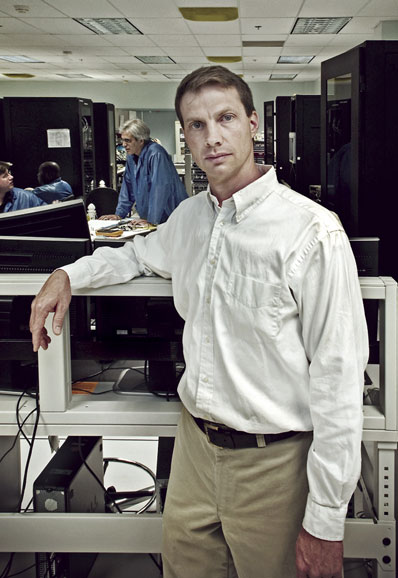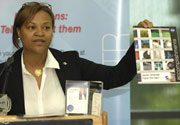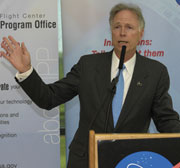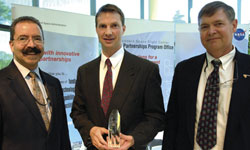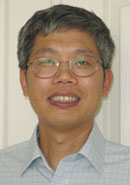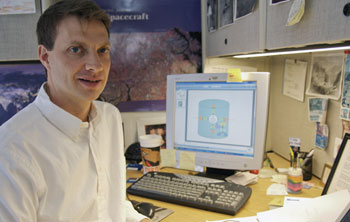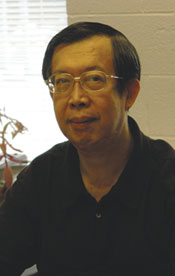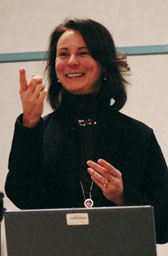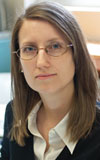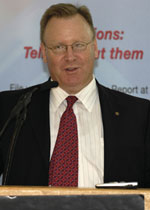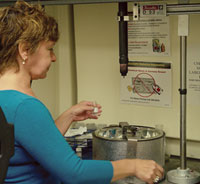|
||||||||||||||||||||||||||||||||||||||||
| volume 5, number 3: SUMMER 2007 |
|
|||||||||||||||||||||||||||||||||||||||
|
[Links followed by * open new browser windows.] |
||||||||||||||||||||||||||||||||||||||||
|
Innovator recognition, education, and presentations were on offer at the 15th annual NTR Program, held May 10 at the Newton White Mansion. Goddard innovators, contractors and personnel gathered to recognize the importance of technology transfer. “The Innovative Partnerships Program (IPP) Office is always working to find new ways to apply Goddard technologies within as well as outside NASA through partnerships as well as identifying external opportunities to infuse technology needs of NASA,” commented Nona Cheeks (Code 504), chief of the IPP Office. “[We] cannot be successful in this mission without your help—and it all begins with the new technology reports, or NTRs, and working with you in identifying technical achievements and needs.” NASA IPP Director Douglas Comstock also took to the podium, emphasizing goals and capabilities of the IPP and motivating staff to shift technology transfer talk from “No, we can’t do this because…” to “Yes, we can do this if…” Greg Olson gives dynamic keynote presentation
Entrepreneur and private astronaut Greg Olson provided further motivation and inspiration as the keynote speaker at this year’s event. A proponent of NASA’s Small Business Innovative Research (SBIR) program, Olson highlighted the program’s benefits and his personal experience founding several businesses, many of which have been involved with SBIR. As the third private citizen to orbit the Earth aboard the International Space Station (ISS), Olson also shared tales from his trip to space, including the research he was able to participate in on board the ISS. Editor’s Note: For more information about Greg Olson, see the article in the Spring 2007 issue of Goddard Tech Transfer News.
Named for an innovator and teacher with a 32-year tenure at Goddard and an exceptional commitment to technology transfer, the annual James Kerley Award recognizes a Goddard innovator with outstanding support for technology transfer and new technology reporting. This year, the award was given to Glenn Rakow for his work related to the SpaceWire protocol for data transmission in flight electronics. “Mr. Rakow was a natural choice as NASA’s SpaceWire Representative. But he has taken that role far beyond expectations,” said former GSFC Deputy Director Mike Ryschkewitsch, who presented Rakow with the award. “Mr. Rakow has worked extensively with the IPP Office to help get his innovative SpaceWire-based designs and his expertise into industry.… His commitment to technology transfer is clear: from filing NTRs for several technologies to identifying industry partners to supporting more than five Space Act Agreements.” The IPP Office congratulates Glenn Rakow on his extraordinary efforts to help further technology transfer at Goddard. For more information about his work, see Innovator Insights. Patent recipients applauded Also recognized as part of the NTR Program were several talented Goddard innovators who had technologies patented in the last year: Jeannette Benavides (Code 562, retired), Vincent Bly (Code 553), and Douglas Leviton (Code 551). |
||||||||||||||||||||||||||||||||||||||||
|
|
What it is: A method and design that reduces the number of optical fiber amplifiers required for laser system applications in which the desired output is high-peak-power, multiple frequency-doubled laser beams. What makes it better: Existing multiple-beam technologies require multiple fiber amplifiers due to the inherent peak-power limitation of fiber amplifiers. This invention circumvents this limitation by enabling a single fiber amplifier to generate multiple frequency-doubled beams of short pulses with high peak power at low duty cycle, as required for many lidar missions. By using a single fiber amplifier, this technology would substantially reduce the cost, mass, size, complexity, risk, and power consumption of lidar transmitters. How it might be used: This technology is useful for applications requiring multiple frequency-doubled laser beams of short pulses with high peak power at low duty cycle. A number of NASA missions in the formulation phase would benefit, including the National Lidar Mapping Initiative, Lidar Surface Topography (LIST) mission, ICESat-II mission, and space missions studying the icy moons (i.e., Europa, Enceladus) of outer planets. The technology would enable NASA to build instruments for these missions with greater spatial coverage and range resolution while providing the benefits noted above. The method is also suitable for applications requiring continuous-wave operation. Tech transfer status: A patent application was filed in April 2007, and Goddard is applying for IPP Seed Funding for this technology. File your New Technology Reports (NTRs) on eNTRe*. For more information, contact Goddard’s IPP Office (6-5810).
|
|||||||||||||||||||||||||||||||||||||||
Glenn Rakow Tell us a bit about the research you’ve been doing for Goddard. For the last three years I’ve been working to improve the avionics architectures for spacecraft here at NASA, primarily to support a wide range of mission requirements, promote reuse, and provide higher performance systems. This effort has involved international standard development with other space agencies such as European Space Agency (ESA)*, Japan Aerospace Exploration Agency (JAXA)*, and Russian Federal Space Agency (ROSCOSMOS)*, and collaborations with U.S. industry partners to develop components to infuse into Goddard missions like James Webb Space Telescope (JWST)*, Geostationary Operational Environmental Satellites – R Series (GOES-R)*, Lunar Reconnaissance Orbiter (LRO)*, and Magnetospheric Multiscale Mission (MMS)*. Central to the work is SpaceWire, which is a European standard that specifies high-speed on-board network communications —scalable point-to-point serial links that form a network between chips, boards, and boxes that is low power, small, and simple to implement. But even though it is simple and loosely defined, it can also make reuse harder. I like to think of it as a piece of moldable clay because we have been working to shape it and define the layers above SpaceWire to foster reuse. Eventually we want to define systems up to the application layer, and SpaceWire is a great communication protocol to support this.
What are some of the improvements you’re working on and the benefits to NASA missions? One major improvement has been to define a standard SpaceWire packet format that is consistent for decoding because the standard permits different packet formats depending upon the type of routing address scheme used. This new format now supports the development of standard protocols through the assignment of protocol identifiers. As a result, several new protocols have been developed. One protocol performs reliable packet delivery that will be used by the GOES-R mission. Another defines memory mapping of packets, which is useful for replacing standard parallel backplanes to increase reliability and reduce mass and power while standardizing transactions between boards and subsystems no matter their location. MMS will use this. I also recently led an international team of engineers to develop the hardware plug-and-play features to support software’s discovery of a network and notification when devices are added or removed. This will first be used by AFRL (Air Force Research Laboratory)* for PnPSat, which is a technology demonstration of a plug-and-play satellite that will be rapidly integrated from standard components. These changes have been incorporated above the (computer communication stack) layers that define SpaceWire. Improvements to SpaceWire itself include adding a cable redundancy mechanism that was developed for JWST and is being used for an NRO (National Reconnaissance Office)* satellite; adding the ability to fuse many discrete signals over the SpaceWire cable to eliminate extra wires for side band signaling (one pps [pulse per second] is a common example of one of these); and adding features to provide network blockage protection into our SpaceWire router design.
You mentioned standardizing to the highest level. Why is this important? Well for one thing, avionics developments are expensive, so in order to be more competitive, we need to come up with methods to foster reuse of both hardware and software—almost as is. We seem to do the same things for every mission we build but just packaged a slightly different way and optimized for that particular mission. I think with a little forethought and buy-in from multiple projects, we could leverage efforts and come up with a scheme to reuse most of what we do. In the case of instruments that are mostly unique, we can define a higher-level interface that software can perhaps handle without too much effort. That all sounds like a tall order. This is a real research project but it is worth pursuing because the potential benefits are great. With federal budget constraints we need to find ways of reducing costs to do more missions and more science—for the good of NASA and space industry in general. What kinds of support are you getting within and outside NASA for this work? There is a very astute team of engineers here at NASA working on SpaceWire issues to make it feasible for real missions. Examples are the physical layer connector and cable improvements led by Shaune Allen to increase the data rate and allow the cable to be broken up into several parts. A second example is the SpaceWire simulators developed by Tom Johnson and Locksley Haynes to emulate SpaceWire components. This is a real production-line effort with over 50 of these things being built and delivered to JWST and other mission customers. Another example is Mike Pagen, JWST engineer, and his work to optimize the design in field-programmable gate arrays (FPGAs) and develop solutions for some tricky implementation challenges. Omar Haddad has done an excellent job verifying our SpaceWire design so that it may be easily maintained and so that customers have confidence in it, and Chris Dailey is working on system-level issues. In addition, Pam Sullivan and Mark Voyton supported the installation of SpaceWire into the JWST Integrated Science Instrument Module (ISIM)*. Without the support of this whole team of talented people none of this would be possible. I am probably missing someone, which is always dangerous when you list names. Outside of NASA we have been receiving support from other government agencies like AFRL and Naval Research Laboratory (NRL)* as well as international support (mainly from ESA) to collaborate on standardization efforts. We have also had a lot of support from U.S. industry to make components to support our work. What have you been doing with the IPP Office? The IPP Office has been very helpful in executing Space Act Agreements (SAAs) involving SpaceWire with four different companies, which will help them integrate SpaceWire into their products. Two companies have also requested to commercialize our technology, which is in process now. And working with the IPP Office has also helped us gain a lot of exposure that we might not otherwise have gotten, through various stories, press releases, events, and just general publicity about what Goddard is doing with SpaceWire. Those efforts have definitely been extremely helpful. As an innovator, half the battle is won through education and communication, and the IPP Office is great at facilitating both. They help “grease the skids” in a lot of respects and help our efforts gain more credibility both within and outside of NASA. It’s so important to be in communication with the Office about the technologies you’re working on, and take an active role in the NTR and commercialization process. Editor’s note: Glenn Rakow received the 2007 Kerley Award for his outstanding technology transfer efforts. What do you see as the value of technology transfer and/or partnering with outside organizations in collaborative R&D? Almost every aerospace company in the country has requested and worked with or evaluated our SpaceWire router design. As these aerospace companies adopt the design, it will streamline the interfaces and architectures across the industry. NASA can then leverage these efforts to make our work even easier.
|
||||||||||||||||||||||||||||||||||||||||
|
|
SBIR/STTR Program to Emphasize Technology Infusion
The Innovative Partnerships Program (IPP) at NASA Headquarters* has changed the structure and execution of the Small Business Innovative Research and Small Business Technology Transfer (SBIR/STTR)* programs. These programs are designed to stimulate technological innovation in the private sector to meet federal research and development needs. The changes to SBIR/STTR are designed to achieve two objectives:
As articulated by NASA IPP Director Douglas Comstock, “These decisions were made in the context of the Agency priority to provide new focus on innovation and technology infusion.” Program consolidation The ten offices that had implemented the administrative and technical aspects of the SBIR/STTR program at each Center have been consolidated to four. These four “primary” Centers are aligned with the four Mission Directorates: Aeronautics Research (Glenn)*, Exploration Systems (Langley)*, Science (JPL)*, and Space Operations (Ames)*. In addition, these Centers also are responsible for needs that cut across multiple directorates, including communication (Glenn) as well as small satellites and human life sciences (Ames). The remaining six Centers will not have to manage any administrative processes. Rather, as supporting Centers, they will work to establish and maintain close working relationships with the programs and projects at the Center, focusing on promoting and facilitating the infusion of SBIR/STTR technology into NASA missions. Consolidating administrative processes from ten to four Centers will result in budget savings that can be applied to the development of other innovative partnerships. Changes at Goddard The Agency program management office (PMO) Level II for SBIR/STTR, which had been located at Goddard, has shifted to Ames Research Center. Yet Goddard will still have a key role in the program as one of the six supporting Centers. Goddard’s SBIR/STTR efforts are being led by Jim Chern, who serves as the SBIR/STTR technology integration manager (STIM). “The STIMs at each Center serve as the key interface for all Mission Directorates, helping them access, mature, apply, and infuse SBIR/STTR technologies quickly, cost effectively, and strategically,” says Chern. STIMs also provide support for assessment of IPP-sponsored technology, portfolio management, infusion strategies, and implementation of technology solutions. Although every Center is organized differently, generally the STIMs at each Center—including Chern—will focus on technical functions:
“The solicitation for 2007 has come out,” says Chern, referring to the list of research topics that represent the Mission Directorates’ high-priority needs. When evaluating new technology reports (NTRs), the IPP Office considers the inventions relative to these research topics, looking for opportunities to “infuse” Goddard technologies in NASA Mission Directorates. “Even though Goddard researchers are not eligible to apply for SBIR/STTR funding, they should see if their technologies align with these topic areas. Where there’s a match, there’s potential for NASA use of the innovation.” Goddard Participation in 2007 SBIR/STTR Research Topics *Goddard is lead Center
For more information about these and other research topics (including those in the Aeronautics Research), visit the full Program Solicitation on the SBIR/STTR* Web site at Goddard or contact Jim Chern (6-5836).
|
|||||||||||||||||||||||||||||||||||||||
|
Test Your TTQ* Up to par on SBIR Test your knowledge of NASA’s SBIR process with these true/false questions.
|
||||||||||||||||||||||||||||||||||||||||
|
|
||||||||||||||||||||||||||||||||||||||||
|
The IPP Office is pleased to announce the following new agreements:
SAA: Space Act Agreement
A new SAA between Goddard and Hampton University calls for the collaborative creation of a new handheld sun photometer to be used for the Cloud-Aerosol Lidar and Infrared Pathfinder Satellite Observations (CALIPSO)* project jointly led by NASA and the French Centre National d’Etudes Spatiales (CNES)* as well as for the Global Learning and Observations to Benefit the Environment (GLOBE) project*, which is a cooperative effort of public schools in partnership with higher education and non-governmental organizations. NASA plans to patent the final design and license the technology to a company with the means to mass produce the photometers and offer them to schools participating in the CALIPSO and GLOBE efforts as well as other interested parties. A new reimbursable SAA between Goddard and Emergent Space Technologies will allow the company non-competitive, after-hours access to and use of Goddard’s Formation Flying Test Bed (FFTB) GPS test and simulation equipment and facilities. Emergent currently staffs, maintains, and operates the Facility on Goddard’s behalf under a separate contract. Under this new agreement, NASA will receive a per-customer reimbursement fee for all non-NASA testing that Emergent performs using the facilities, while Emergent will save start-up and development costs by using NASA’s facilities rather than investing the large amount of capital required to develop comparable facilities. A new nanotechnology company, Nanotailor, has licensed Goddard’s unique single-walled carbon nanotube (SWCNT) fabrication process with plans to make high-quality, low-cost SWCNTs available commercially. Potential markets for the technology are vast and include medicine, construction, manufacturing, imaging, and others. The license provides Nanotailor a springboard from which to grow its business, and Goddard will receive royalty revenue from the agreement. Editor’s Note: Goddard’s SWCNT fabrication process was recently named a Nano 50 award winner. American GFM has also licensed Goddard’s SWCNT fabrication process. The company plans to add SWCNT production to its already successful business of manufacturing equipment to produce composite materials. The license will make SWCNTs even more widely available to nanotechnology commercial markets, and Goddard will also receive royalty revenue from the company’s sales. A reimbursable SAA between Goddard and Lockheed Martin will enable collaborative testing of Goddard’s “Navigator” GPS receiver, helping researchers determine whether it can meet the navigation requirements of the GOES-R program. If successful, the Navigator may help reduce operational risk for the program, and may benefit future misions requiring onboard GPS-based navigation for NASA, the National Oceanic and Atmospheric Administration (NOAA)*, Department of Defense*, and the commercial space industry. A reimbursable SAA between Goddard and SEGMA will provide NASA the unique opportunity to apply its technological expertise in the new and exciting field of business governance. Collaboration between Goddard and SEGMA will be directed toward applying an intelligent robotic system to an automated corporate governance rating system, resulting in a business intelligence tool referred to as “KAELO.” Goddard will be able to apply this learning to understanding the roles of autonomous systems in the Moon’s environment. Visit success stories to read about other technology transfer agreements and success stories. |
||||||||||||||||||||||||||||||||||||||||
Goddard Innovator Receives Valuable Critiques and Contacts at MIT Enterprise Forum Tech Transfer Lab
Goddard innovator Stephanie Getty, along with members of Goddard’s IPP Office, attended the MIT Enterprise Forum’s* (MITEF’s) third annual Technology Transfer Lab on May 22. Focused on the hottest mobile technologies from university and federal labs throughout Maryland and Virginia, this year’s event offered technologists an opportunity to receive valuable critiques, suggestions, and comments to help further the commercial viability of their innovations. It also offered the MITEF audience (which included venture capitalists, private investors, local companies, and entrepreneurs) exposure to new, cutting-edge technologies coming out of area labs. Getty was one of only six innovators selected by MITEF to present at the event. Her patented NanoCompass technology—a lightweight, low-power magnetometer based on a SWCNT network—was well-received by the panel of experts who provided Getty with feedback related to cost-competitiveness, finding approachable markets, and narrowing applications. “Presenting to this panel was a very valuable experience,” commented Getty. “I anticipate that the suggestions, critiques, and contacts I received will be very useful as we continue to work toward commercialization of the NanoCompass.” Editor’s Note: For more information about Stephanie Getty and her NanoCompass technology, see her profile in the Spring 2007 issue of Goddard Tech Transfer News.
Goddard Technologies and IPP Represented at SAMPE 2007 IPP personnel and Goddard innovators were among the presenters at the 2007 conference of the Society for the Advancement of Material and Process Engineering (SAMPE)*, at the Baltimore Convention Center June 3–7. IPP Director Douglas Comstock was invited to present the keynote address, highlighting the role of the IPP and technology transfer partnerships in achieving NASA’s strategic goals, of which materials science plays a prevalent and important role. Goddard innovators Stephanie Getty and Betsy Pugel were also invited to present at the conference, which boasted nearly 300 exhibitors and was attended by nearly 4,000 members of the materials science community. Getty presented information about her NanoCompass technology (see story above), while Pugel gave the audience insight into her novel non-destructive method of evaluating thermal protection system materials for use in aerospace missions. IPP Offers a Strong Presence at NASA Day on the Hill: “Leading Today for a Better Tomorrow” Members of Goddard’s IPP Office, including Chief Nona Cheeks, attended the second annual NASA Day on the Hill on June 20 at the Rayburn House Office Building. The all-day event was open to members of Congress, their staffers, and the general public and featured interactive exhibits, targeted handouts, and speakers and staff from across the Agency to educate attendees and the press about current NASA operations and the importance of NASA to local communities. As the only mission support office invited to share the day with the Mission Directorates, the IPP presented a memorable message through a popular display highlighting the importance of pursuing partnerships with the emerging commercial space sector, and demonstrating how NASA’s research today will affect life tomorrow. As a result of this success, the Innovative Partnerships Program has been invited to be a part of future Day on the Hill events. |
||||||||||||||||||||||||||||||||||||||||
Federal Funding Solicitations Search relevant labs and contacts for possible funding opportunities Goddard civil servants and contractors can search the online Other Government Agency (OGA) Reference page on the IPP Office Web site to help identify relevant labs and points of contact at other government organizations. Through this resource, Goddard researchers can establish relationships with government organizations for technology infusion and future funding opportunities. The document covers many technology areas, including:
Initial submissions made through this page require only a one-page executive summary. Access the federal funding opportunities page online (see the link on the left-hand side). For more information, please contact Nannette Stangle-Castor of Goddard’s IPP Office at 919-873-1457.
|
||||||||||||||||||||||||||||||||||||||||
|
Goddard’s Method for Manufacturing High-Quality Carbon Nanotubes has been named a winner in the third annual Nanotech Briefs’ * Nano 50 Awards in the Technology category. Until recently, carbon nanotube use has been limited due to the complex, dangerous, and expensive methods for their production. However, retired Goddard innovator Jeannette Benavides developed a simpler, safer, and much less expensive manufacturing method. The key innovation in the patented process was its ability to produce bundles of carbon nanotubes without using a metal catalyst, dramatically reducing pre- and post-production costs while generating higher yields and greater purity. Presented by Nanotech Briefs magazine—the monthly digital publication from the publishers of NASA Tech Briefs*—the Nano 50 recognizes the top 50 technologies, products, and innovators that have significantly impacted, or are expected to impact, the state of the art in nanotechnology. The winners of the Nano 50 Awards are the “best of the best”—the innovative people and designs that will move nanotechnology into key mainstream markets. Jeannette Benavides will receive her Nano 50 Award at a special awards dinner to be held during the NASA Tech Briefs National Nano Engineering Conference* in Boston, November 14–15, 2007. Inventions and Contributions Board Awards ICB* recognized the following software release and Tech Briefs awards for Q3 FY07: Software Release Awards
For more details, contact Dale Hithon or visit NASA Awards. |
||||||||||||||||||||||||||||||||||||||||
|
||||||||||||||||||||||||||||||||||||||||
|
You can report new project technologies through the online eNTRe* system. |
||||||||||||||||||||||||||||||||||||||||
|
Chief: Nona Cheeks Goddard Tech Transfer News is the quarterly magazine of the Innovative Partnerships Program Office (Code 504) at NASA Goddard Space Flight Center in Greenbelt, Maryland. This magazine seeks to inform and educate civil servant and contractor personnel at Goddard*, as well as at Wallops Flight Facility* and the Independent Verification and Validation (IV&V) Facility*, about actively participating in achieving NASA’s technology transfer goals:
Please send suggestions or feedback about Goddard Tech Transfer News to the editor or go to our online feedback system*. |
||||||||||||||||||||||||||||||||||||||||
|
||||||||||||||||||||||||||||||||||||||||


